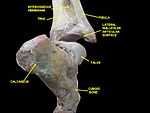Calcaneus
| Calcaneus | |
|---|---|
 | |
| Subtalar Joint | |
 | |
| Left calcaneus, lateral surface. | |
| Latin | Calcaneus, os calcaneum, os calcis |
| Gray's | p.263 |
| MeSH | Calcaneus |
| TA | A02.5.11.001 |
| FMA | FMA:24496 |
In humans, the calcaneus (/kælˈkeɪniːəs/; from the Latin calcaneum, meaning heel[1]) or heel bone is a bone of the tarsus of the foot which constitutes the heel. In some other animals, it is the point of the hock.
Structure

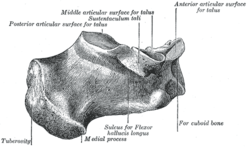
In humans, the calcaneus is the largest of the tarsal bones and the largest bone of the foot. The tarsal bones of the ankle are arranged in proximal and distal groups somewhat like the carpal bones of the wrist. Because of the load-bearing role of the ankle, however, their shapes and arrangement are conspicuously different from those of the carpal bones, and they are thoroughly integrated into the structure of the foot. In the calcaneus, several important structures can be distinguished:[2]
The posterior half of the bone is the tuber calcanei. On its lower edge on either side are its lateral and medial processes (serving as the origins of the abductor hallucis and abductor digit minimi). The calcaneal (Achilles) tendon is inserted into a roughened area on its superior side, the cuboid bone articulates with its anterior side, and on its superior side are three articular surfaces for the articulation with the talus bone. Between these superior articulations and the equivalents on the talus is the tarsal sinus (a canal occupied by the interosseous talocalcaneal ligament). On the medial side of the bone, below the middle talar facet, is the sustentaculum tali (which serves for the attachment of several other ligaments). On the lateral side is commonly a tubercle called the peroneal trochlea, under which is a groove for the tendon of the peroneus longus. The talus, calcaneus, and navicular are considered the proximal row of tarsal bones. [2]
With normal axial alignment in the hindfoot, the axes of the tibia and calcaneus lie on a vertical line (pes rectus). If the calcaneal axis is turned medially the foot is in an everted position (pes valgus), and if it is turned laterally the foot is in an inverted position (pes varus). [3]
In other animals
The calcaneus has two articulations, being part of the Proximal intertarsal joint and the Talocalcaneal joint. As in humans it is the insertion of the gastrocnemius and superficial digital flexor tendons. The point of the calcaneus is covered by the calcanean bursa.
Development
In the calcaneus, an ossification center is developed during the 4-7th week of fetal development. [2]
Function
The calcaneus serves as the insertion point for three muscles: the gastrocnemius, soleus, and plantaris. These muscles have a variety of functions to include plantar flexion of the foot, flexion of the knee, aids in walking, running, jumping, and steadies leg on ankle during standing. All of these muscles are innervated by the tibial nerve and compromise the posterior (flexor) compartment of the leg.
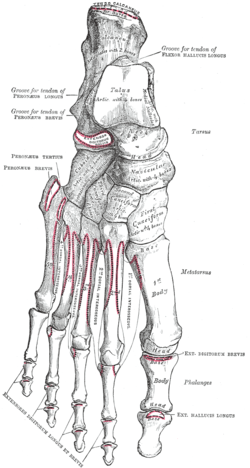 Muscle attachments (seen from above) | 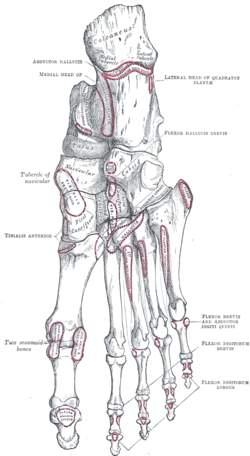 Muscle attachments (seen from belowe) |
| Muscle | Direction | Attachment[4] |
| Gastrocnemius | Insertion | Tuber calcanei through the achilles tendon |
| Soleus | Insertion | Tuber calcanei through the achilles tendon |
| Plantaris | Insertion | Tuber calcanei either directly or through the achilles tendon |
| Extensor digitorum brevis | Origin | Dorsal side of calcaneus |
| Abductor hallucis | Origin | Medial process of calcaneus |
| Extensor hallucis brevis | Origin | Dorsal side of calcaneus |
| Abductor digiti minimi | Origin | Tuber calcanei |
| Flexor digitorum brevis | Origin | Tuber calcanei |
| Quadratus plantae | Origin | Lateral and medial processes of calcaneus |
Clinical significance
See also
This article uses anatomical terminology; for an overview, see anatomical terminology.
- Calcar
- Calcaneal fracture, also known as Lover's fracture and Don Juan fracture
Additional images
-
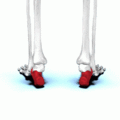
Foot bones. Calcaneus shown in red.
-
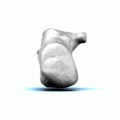
Left calcaneus. Animation.
-

Calcaneus - superior view
-

Calcaneus - inferior view
-
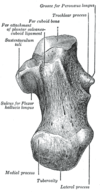
Left calcaneus, inferior surface
-

Bones of the right foot. Dorsal surface.
-

Bones of the right foot. Plantar surface.
-

Skeleton of foot. Medial aspect.
-

Skeleton of foot. Lateral aspect.
-
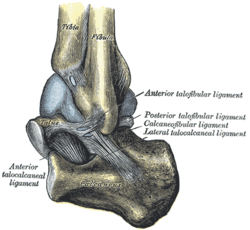
Capsule of left talocrura articulation (distended). Lateral aspect.
-

Coronal section through right talocrural and talocalcaneal joints.
-

Talocalcaneal and talocalcaneonavicular articulations exposed from above by removing the talus.
-

Oblique section of left intertarsal and tarsometatarsal articulations, showing the synovial cavities.
-

Calcaneus fracture X-ray
-
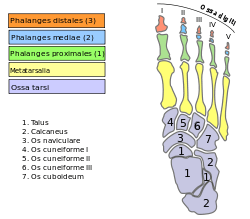
Bones of foot
-
Dorsum and sole of Foot. Ankle joint. Deep dissection.
-
Ankle joint. Deep dissection. Medial view
-
Knee, tibiofibular and ankle joints.Deep dissection. Anterolateral view.
-
Ankle joint. Bones of foot.Deep dissection.
-
Ankle joint. Bones of foot.Deep dissection.
Notes
- ↑ Mosby’s Medical, Nursing and Allied Health Dictionary, Fourth Edition, Mosby-Year Book Inc., 1994, p. 242
- ↑ 2.0 2.1 2.2 Platzer (2004), p 216
- ↑ Thieme Atlas of Anatomy (2006), p 410
- ↑ Bojsen-Møller, Finn; Simonsen, Erik B.; Tranum-Jensen, Jørgen (2001). Bevægeapparatets anatomi [Anatomy of the Locomotive Apparatus] (in Danish) (12th ed.). pp. 364–367. ISBN 978-87-628-0307-7.
References
- Platzer, Werner (2004). Color Atlas of Human Anatomy, Vol. 1: Locomotor System (5th ed.). Thieme. ISBN 3-13-533305-1.
- Thieme Atlas of Anatomy: General Anatomy and Musculoskeletal System. Thieme. 2006. ISBN 1-58890-419-9.
- Saladin, Kenneth (2012). Anatomy and Physiology, The Unity of Form and Function. McGraw Hill. pp. 270–271. ISBN 978-0-07-337825-1.
- "Calcaneus (Heel Bone) Fractures". American Academy of Orthopaedic Surgeons. Retrieved 13 Dec 2012.
External links
| Wikimedia Commons has media related to Calcaneus. |
- lljoints at The Anatomy Lesson by Wesley Norman (Georgetown University) (posterioranklejoint)
| ||||||||||||||||||||||||||||||||||||||||||||||||




